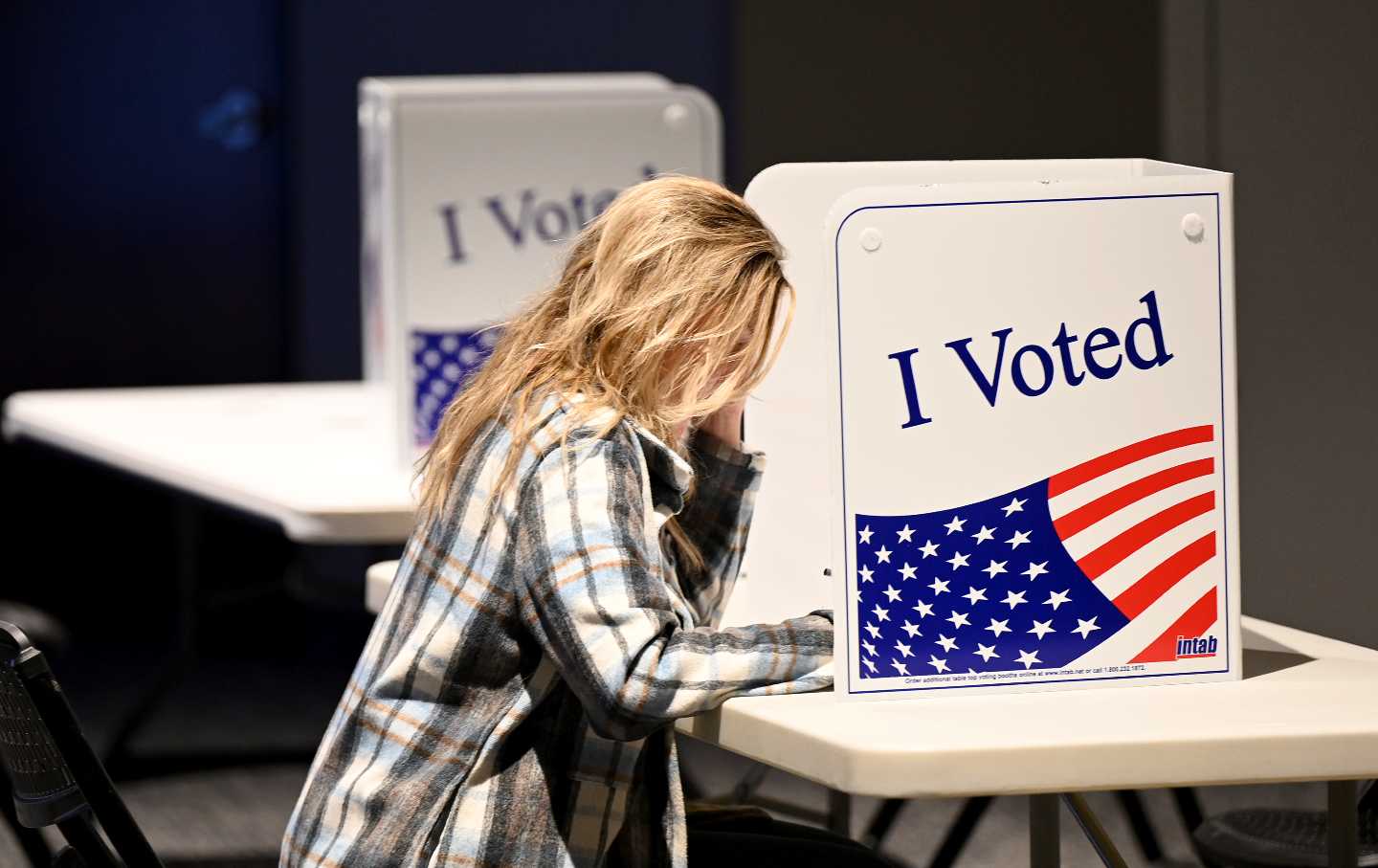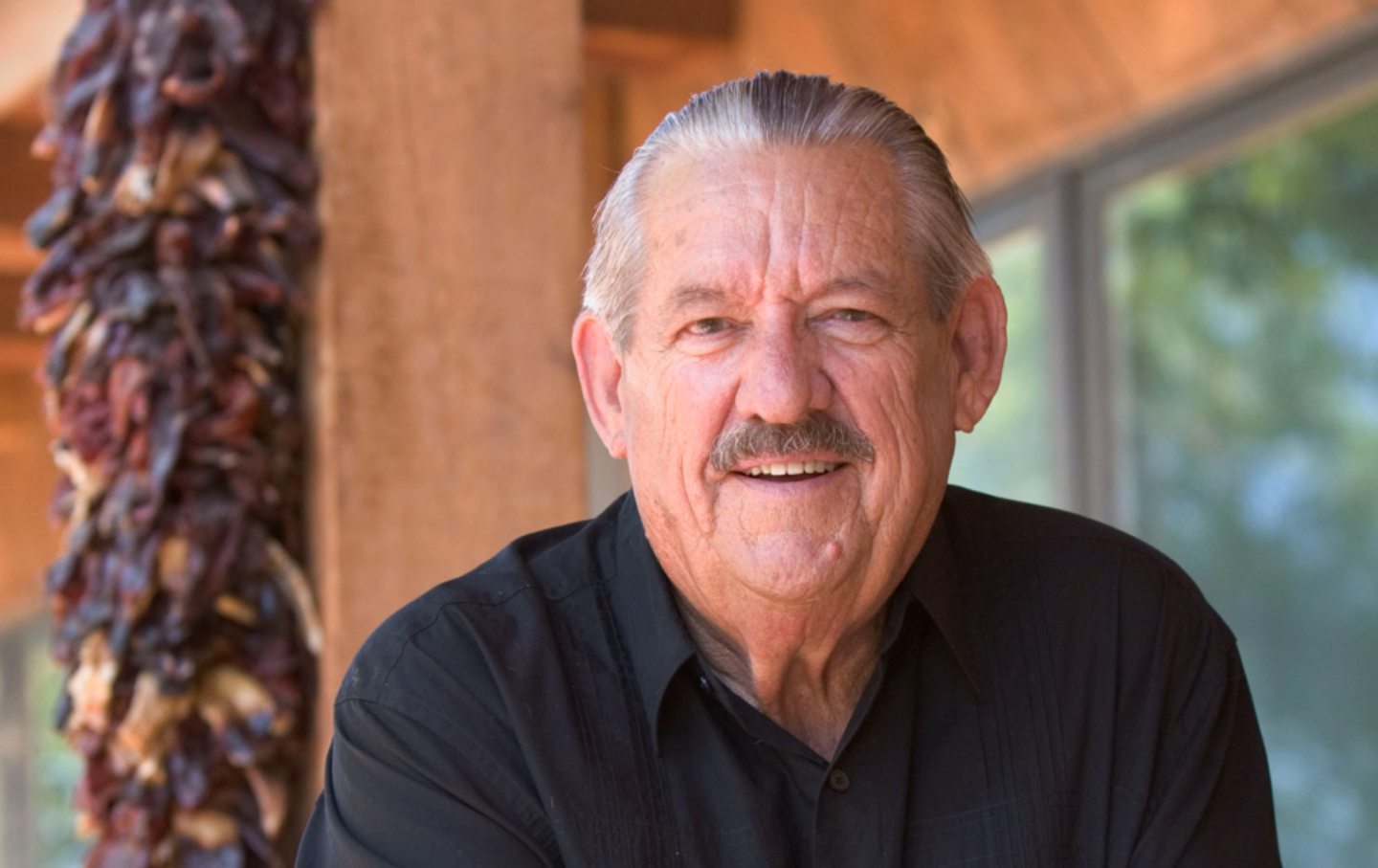Automakers Don’t Need to Choose Between Labor and Climate
Corporations say they can’t meet the UAW’s demands while also transitioning to electric vehicles. The truth is they just need to fork over the money.

Electric vehicles on the production line at General Motors’ Factory ZERO all-electric vehicle assembly plant in Detroit, Mich.
(Emily Elconin / Getty Images)The United Auto Workers are entering their third week of the first-ever simultaneous strike against the three big automakers, and for the first time, a sitting US president, Joe Biden, joined them on the picket line. Executives at General Motors, Ford, and Stellantis are pushing back on worker demands by invoking the climate crisis. They say it is impossible to give workers what they want while also making a swift transition to manufacturing electric vehicles.
On September 14, Ford’s CEO Jim Farley said that the union’s demands—higher wages, better hours, an end to tiered employment, and guaranteed job security in a green energy transition—could send the company into bankruptcy. Mary Barra, the CEO of GM, said that the union’s demands are “unrealistic” and would make GM less competitive. Major outlets have echoed these claims, even arguing that the UAW’s strike will harm the environment by stalling EV production.
But these corporate arguments are undercut by the fact that these companies have authorized billions in stock buybacks, special dividends, and executive compensation. The automakers could have invested that money into worker compensation and electric vehicles, but instead steered it toward stockholders.
People with experience in government seem to be on their side. In 2009, Steve Rattner, President Barack Obama’s former “car czar” and the original negotiator of the post-2008 GM bankruptcy deal, helped the UAW to accept $11 billion in cuts to wages and benefits. Now, Rattner claims that workers’ demands are overly audacious and could cause Democrats to lose the next presidential election.
Simultaneously, corporate media has focused on how the strike could harm American consumers, while ignoring the fact that autoworkers cannot even afford to purchase the very cars that they build. Perhaps the most complex challenge to the union’s demands however, is the critique that the UAW—most of whose members support a move toward electric vehicles—will ultimately harm the environment.
Shawn Fain, the union’s reformist new president, has endorsed Biden’s plan to increase electric vehicle production, but insists that any government-backed transition to electric vehicles protects union jobs by mandating contracts for projects that receive government funding. At least 100 environmental groups have supported this demand.
The Big Three have long been obstacles to a green transition. By the 1960s, scientists at the major automakers knew that carbon monoxide, nitrogen oxides, and hydrocarbons produced in car exhaust contributed to climate change. And in the 1980s, instead of investing in new technology, GM began authorizing stock buybacks and special dividends and tying CEO compensation to stock performance.
But in the 1990s, GM still had a chance to lead the industry’s turn to electric vehicles. By 1996, GM had thousands of electric cars on the roads, which it literally crushed three years later after backhand dealing from the fossil-fuel industry relaxed government mandates to build EVs, and allowed automakers to give up on the project.
As GM spent more on buybacks, the company shrank. In 1986, GM employed nearly 900,000 people. Today, it employs 167,000.
GM and other auto manufacturers are making the same mistake again. During the pandemic, profits at the Big Three spiked by 65 percent, as they used the supply-chain shortage to raise prices. Instead of reinvesting these profits in EV technology or workers—with the exception of mild boosts in profit-sharing—the companies authorized $5 billion in buybacks in 2022, a 1,500 percent increase from the year prior.
In February of this year, Ford announced a record $2.6 billion special dividend on top of its typical quarterly dividend of about $600 million. All told, Ford has spent over $4.3 billion on dividends since November of last year. Stellantis has issued about $4.1 billion in dividends this year, while GM is set to distribute half a billion in dividends to its shareholders this.
Union workers hardly benefit from buybacks and excessive dividends. At the Big Three automakers, CEO salaries have gone up by 40 percent in the four years since the last UAW contract. Ford CEO James Farley received nearly $21 million in total compensation in 2022, a 21 percent increase over the $17.4 million then-CEO Jim Hackett received in 2019. Farley’s package last year included $15.1 million in stock awards.
Similarly, GM’s CEO Barra makes $29 million a year—362 times her company’s median employee salary. In an interview with CNN, Barra explained that 92 percent of her compensation is “performance based,” meaning that much of her pay is determined by the company’s stock value. In “pay package” arrangements, executives are paid in stock, or equity, but are only allowed to cash that stock when its value reaches a certain threshold.
Popular
“swipe left below to view more authors”Swipe →When companies buy back their stocks, it removes shares from the market, increasing the value of the shares that people already hold. It’s particularly beneficial for share sellers, like private-equity and hedge-fund managers, who can sell those shares at a profit.
The US government considered these stock buybacks a form of “market manipulation” like insider trading until 1982, when President Ronald Reagan’s administration legalized them as part of his deregulatory, free-market “Reagan Revolution.”
All of this stock manipulation comes at the cost of investments that ensure a company’s ability to exist in the long term, like on workers, innovation, and manufacturing capacity. Bill Lazonick, an economist at the University of Massachusetts, was particularly critical of automakers’ participating in the buyback trend. “There’s absolutely no way a company like General Motors, given the competition in the industry and the need for the EV transition, should be doing these buybacks.”
From pharmaceutical manufacturers and major tech giants to petrochemical companies, corporations across the economy have hollowed out their own companies to pay shareholders. In an analysis, Lazonick found that between 2012 and 2021, the 474 corporations included in the S&P 500 Index funneled $5.7 trillion into stock buybacks, or 55 percent of their combined net income. They also paid $4.2 trillion to shareholders as dividends, another 41 percent of their net income.
In 2022, these companies set records for stock buybacks, spending more than $923 billion in total. That’s nearly a trillion dollars that companies could have invested in workers or more sustainable production—instead, they enriched Wall Street.
It’s especially troubling for companies in critical industries to be spending their capital on buybacks when they could be investing in capacity. Progressive lawmakers pointed out that the fledgling American semiconductor industry spent $250 billion on buybacks between 2011 and 2020, rather than on research and development, even though this technology plays a critical role in the nation’s renewable energy transition.
“It’s vast amounts of money that could be reinvested in the economy, and certainly in climate solutions,” Lazonick said. “Anybody who’s concerned about this should be looking at this and understanding how that money is being wasted, how their priorities are all lost.”
Labor organizations and climate activists share a common goal: a new economy that pays workers fairly and doesn’t destroy the earth. Both groups realize that an equitable economy is a path both to empowering workers and protecting the climate. They understand that predatory wealth extraction like stock buybacks are obstacles. Trevor Dolan, the industry and workforce policy lead at climate advocacy group Evergreen Action, explained, “Climate groups stand in solidarity with workers, because this is an inflection point in the green energy transition.”
A major energy transition could mean millions of new jobs. Experts estimate that it would require a $275 trillion investment by 2050 to fully transform our economy. Dolan noted that the UAW fight is one of the first major opportunities to prioritize equitable economic development in the renewable economy: “The UAW sees the energy transition. They just want their fair share. They stand in solidarity with us, too.”
Climate activists, who marched across New York City last week, are demanding that fair labor stipulations be included in the Green New Deal. Unions are fighting for a seat at the table as the government considers projects to revamp the electrical grid, expand renewable energy production, and build adaptive climate infrastructure. “This is the first major confrontation in the transition to a green economy between workers and the billionaire class, but it won’t be the last,” said Dolan.
Corporations are trying to pit workers and the environmental movement against each other, but the billions in stock buybacks shows that there is money both for workers and investing in a green future.
As vice president, Biden was critical of stock buybacks—though he’s softened on the practice as president. In a 2016 op-ed in The Wall Street Journal, Biden argued that an overemphasis on share price and performance-based compensation led to company executives’ focusing more on share performance than on long-term investment in a company’s resources.
As Biden moves to make good on his promise to be America’s most pro-labor president, standing on the picket line isn’t enough. To truly support workers, he should make sure that companies’ financial incentives are aligned with their workers’ needs.
Banning stock buybacks, excessive shareholder dividends, or skyrocketing executive compensation would reset company incentives and free up trillions of dollars for workers and climate. There are enough resources to implement transformational technology and ensure that workers can live dignified lives. Labor organizers and climate activists have a common enemy: a billionaire class intent on hoarding resources for themselves.
More from The Nation

My Dystopian Novel Predicted Trump 2.0 My Dystopian Novel Predicted Trump 2.0
SOLIS was meant to serve as a warning of what could come. With Trump’s reelection, it should serve as a blueprint for the bravery and activism needed to fight back.

The Fall of Syria Changes Everything The Fall of Syria Changes Everything
Retired diplomat Chas Freeman and writer Pascal Lottaz discuss what happens now that Damascus is in the hands of Hayat Tahrir al-Sham.

My Brother Chef Mahmoud Almadhoun Died Because He Fed Gaza’s Starving Citizens My Brother Chef Mahmoud Almadhoun Died Because He Fed Gaza’s Starving Citizens
His killing by Israel sent a chilling message that no one is safe, including humanitarians who stand in the way of Gaza’s erasure.

Enough With the Bad Election Takes! Enough With the Bad Election Takes!
To properly diagnose what went wrong, we need to look at the actual number of votes cast.




